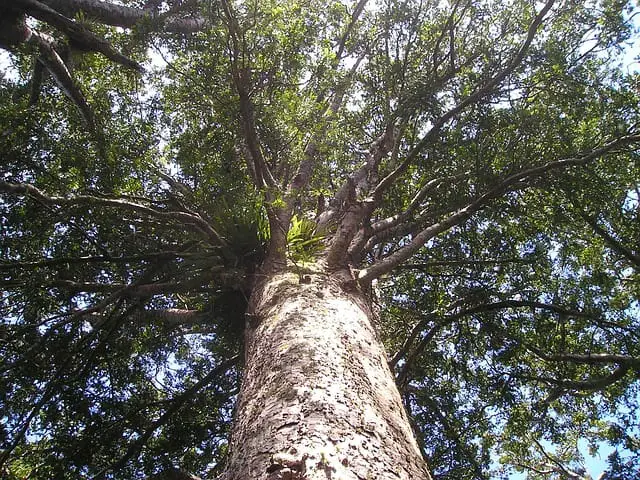The New Zealand Kauri tree, also known as Agathis australis, is a large and majestic evergreen tree native to the warmer northern part of the North Island of New Zealand particularly in the Auckland and Coromandel Peninsula areas. These trees can grow up to 50 m tall (164′) and have a trunk diameter of up to 5 m (16′). They are known for their straight trunk, symmetrical crown, and dark green foliage.
The Kauri tree has a long and rich history in New Zealand, with the indigenous Maori people using the tree for various purposes such as building houses, canoes, and carving. The Kauri tree is also known for its durable and strong wood which has been used for construction, furniture, and flooring. The wood is also highly valued for its unique characteristics such as its straight grain, uniform texture, and natural resistance to decay.
In addition to its practical uses, the Kauri tree also has many benefits for the environment. The tree acts as a carbon sink, absorbing carbon dioxide from the atmosphere and storing it in its wood, leaves, and roots. Kauri trees also provide important habitat for native wildlife and support a diverse ecosystem.
Having said that, the commercial desirability of the Kauri along with natural predators like kauri dieback has caused the tree to be protected in many parts of New Zealand as we’ll see below.
New Zealand’s Kauri Tree Explained
Here’s a table with important information and characteristics, commercial uses and growing conditions for the Kauri tree:
| Aspect | Description |
|---|---|
| Tree Species | Kauri (Agathis australis) |
| Tree Height | Up to 164 feet (50 meters) |
| Leaves | – Evergreen with needle-like leaves |
| – Arranged spirally around the branches | |
| – Dark green color and glossy appearance | |
| Wood Characteristics | – Highly prized for its quality and durability |
| – Fine, straight grain | |
| – Warm golden-brown to reddish-brown color | |
| – Resistant to decay and insect attack | |
| – Low shrinkage and minimal movement | |
| Commercial Uses | – High-end furniture and cabinetry |
| – Flooring and paneling | |
| – Decorative carvings and sculptures | |
| – Boatbuilding and ship masts | |
| – Musical instruments, especially guitars | |
| Growing Conditions | – Native to New Zealand |
| – Prefers subtropical and temperate climates | |
| – Grows best in well-drained, moist soils | |
| – Often found in lowland and montane forests | |
| – Slow-growing, long-lived tree |
The Kauri tree (Agathis australis) is a remarkable species found in New Zealand. It can reach heights of up to 164 feet (50 meters) and features evergreen needle-like leaves arranged spirally around its branches.
Kauri wood is highly valued for its quality and durability, displaying a fine, straight grain and warm golden-brown to reddish-brown color. Its resistance to decay and insects makes it ideal for high-end furniture, cabinetry, flooring, paneling, decorative carvings, sculptures, boatbuilding, and musical instruments, particularly guitars.
Kauri thrives in subtropical and temperate climates, preferring well-drained, moist soils in lowland and montane forests, where it grows slowly but can live for a long time.
Threats To The Kauri Tree Are Numerous
However, the Kauri tree is currently facing threats from a fungal disease known as kauri dieback, which has affected large areas of the Kauri forest. This disease is spread through the soil, and can be transmitted through human activity such as walking on contaminated soil. The disease has led to the death of many Kauri trees and has prompted conservation efforts to protect and preserve the remaining Kauri forest.
There is no known cure for the disease currently and what makes it worse is that even a small amount of contaminated soil around the tree can spread quickly.
Kauri Is An Expensive And Desirable Wood
Due to its beauty, strength, and ecological importance, Kauri wood is highly sought after and can be quite expensive. A Kauri flooring board of a good quality can cost around $50 – $100 per square meter. A beautiful Kauri table can cost anywhere from $1000 – $5000, depending on the size and quality of the wood. Kauri furniture is highly prized for its durability, and can last for several decades with proper care.
This commercial desirability has contributed to the over harvesting over time which has led to the protected status of the tree in parts of New Zealand.
of the tree in parts of New Zealand.
Kauri Is Not Used For Burning Or Smoking
While Kauri wood is prized for its quality and durability, it is not typically used for smoking foods. Kauri wood is valued for its slow growth and rarity, making it a valuable material for high-end furniture, cabinetry, and decorative items. Due to its scarcity and unique properties, using Kauri wood for smoking foods is not a common practice.
When it comes to smoking foods, other woods are more commonly used because they offer distinct flavors and aromas that enhance the taste of the food. Woods like hickory, mesquite, apple, cherry, and oak are popular choices for smoking various meats and vegetables due to their unique and flavorful smoke profiles.
If you’re looking for New Zealand woods for smoking foods, consider manuka, kanuka and pohutukawa.
Summary
In conclusion, the New Zealand Kauri tree is a truly remarkable species with a rich history and many uses. Its wood is highly valued for its strength and beauty, and the tree has many benefits for the environment as well.
However, the Kauri tree is currently facing threats from kauri dieback, and conservation efforts are needed to protect and preserve the remaining Kauri forest. Despite its high cost, Kauri wood remains a desirable choice for those looking for a durable and unique piece of furniture or flooring.

